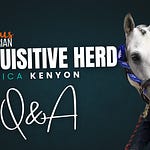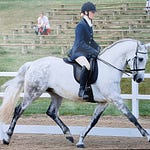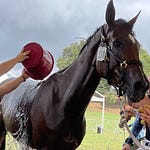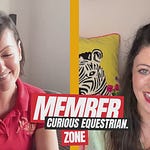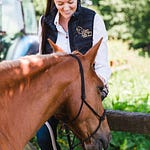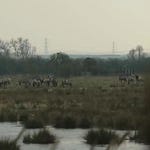Most people assume great horsemen are born with natural charisma and commanding presence. Ben Longwell's story completely shatters that myth. Growing up on Colorado's Western Slope, he was the kid who quiet kid – yet today, he presents at international horse expos and mentors riders worldwide through his work with True West Horsemanship.
Images: Natalie Longwell, Giles Pike, Jon Longwell, and Nick Grant.
The Quiet Revolution: When Introverts Lead Horses
The horse industry often celebrates the loudest voices, the charismatic clinicians who command attention and dominate arenas. However, Ben Longwell proves that authentic leadership comes from consistency and authenticity, not personality type.
"I faced it every day. I learned how to cope with nerves and butterflies in the stomach on a regular basis and pushed myself to face that and to do the thing that I was scared of," Ben explains about his journey from shy ranch kid to internationally recognized trainer.
This transformation wasn't about changing his personality but finding his authentic voice through service to horses and students. When his wife Natalie volunteered him to present at New Zealand's first National Horse Expo just six months after moving there, Ben was terrified but discovered something crucial: horses and audiences respond to genuine knowledge shared authentically, not polished performance.
Why This Matters for Every Horse Person
Ben's approach directly challenges our industry's obsession with dominance-based training and charismatic leadership. As he puts it: "It needs to be real. It has to be authentic. It's not a show... I'm not a showman."
This principle extends beyond public speaking to every interaction with horses. They respond to genuine leadership and clear, consistent communication from someone who understands their needs – not theatrical displays of "alpha" behaviour.
Practical Application: If you're nervous about riding in front of others or feel intimidated by more experienced horsemen, focus on developing clear communication skills rather than trying to project confidence you don't feel. Horses can sense authenticity, and genuine knowledge communicated clearly will always outperform fake bravado.
The Revolutionary Difference: Nice vs. Kind Leadership
Perhaps no concept from Ben's teaching challenges conventional wisdom more than his distinction between being "nice" and being "kind" to horses. Most riders confuse gentleness with effective leadership, but Ben argues this confusion creates problems for both horse and rider.
"Niceness could be viewed by the horse as weakness or lack of clarity. I call it wishy-washy... whereas kindness is different than that. Kindness tells you when your zipper is down. Kindness speaks the truth in love."
Understanding the Critical Difference
Being "Nice" Often Means:
Avoiding necessary corrections to prevent upsetting your horse
Inconsistent boundaries because confrontation feels uncomfortable
Allowing inappropriate behaviour because correction seems "mean"
Tiptoeing around problems, hoping they'll resolve themselves
Being "Kind" Requires:
Clear, immediate correction of inappropriate behaviour
Consistent boundaries that help horses understand expectations
Fair consequences followed by return to relationship-building
Honest communication that serves the horse's best interests
This distinction transforms how we approach everything from basic ground manners to complex training challenges. Instead of avoiding problems, kind leadership addresses issues directly while maintaining emotional connection and respect for the horse.
Real-World Applications
Ben shared examples of how this plays out practically:
A horse that crowds your space needs immediate, clear correction – not gentle nudging that confuses the message
Ground manners issues require consistent boundaries, not apologetic corrections
Training problems need honest assessment and direct solutions, not endless accommodation
Action Step: Examine your last three interactions with your horse. Were you being "nice" (avoiding necessary corrections) or "kind" (providing clear, helpful guidance)? Most riders discover they've been unintentionally "nice" when their horses needed clarity.
Rediscovering Ancient Wisdom: The Bridle Horse Tradition
When Ben discusses the California vaquero bridle horse tradition, you're witnessing someone who's spent decades preserving knowledge that nearly vanished. By the mid-1900s, this centuries-old approach to developing the ultimate partnership horse had almost disappeared, saved only by isolated Great Basin ranches and horsemen like Tom Dorrance and Ray Hunt.
"The bridle horse is potentially the best, highest level of riding and horsemanship there is because it doesn't borrow from Western and English. It is the roots of Western and English."
What Makes Bridle Horse Training Different
The bridle horse tradition developed horses that could:
Perform advanced classical movements while maintaining practical cattle-working ability
Respond to the lightest possible aids without losing emotional connection
Work dangerous wild cattle requiring split-second precision and trust
Maintain athletic ability and willing partnership throughout long working days
This wasn't about creating pretty movements for show, it was about survival. Vaqueros needed horses that could navigate dangerous situations with minimal rider input while maintaining the relationship necessary for daily work.
Modern Applications of Ancient Principles
For Western Riders:
Focus on developing lightness before adding speed or complexity
Build emotional connection alongside technical skills
Prioritize the horse's understanding over mechanical compliance
For English Riders:
Apply bridle horse principles to develop true collection based on partnership
Use vaquero timing concepts to improve communication
Integrate relationship-building with technical training
For All Disciplines:
Study how traditional horsemen developed willing partnership without force
Learn to read horses more accurately through vaquero observation methods
Apply the patience and systematic progression that created bridle horses
Resources for Learning More: Ben recommends studying the work of Tom Dorrance, Ray Hunt, and Buck Brannaman as entry points into understanding these traditional methods.
Confidence Reconstruction: The Ground-Up Approach
One of the most common challenges Ben encounters is experienced riders who've lost their confidence. Whether through injuries, time away from horses, or challenging experiences with new mounts, many skilled riders find themselves paralyzed by fear that seems to come from nowhere.
Ben's approach challenges the common advice to "just get back on and push through it."
The Real Story of Confidence Loss
Ben shared the story of an accomplished upper-level dressage rider who lost confidence in cantering after a difficult experience with a new horse. Rather than focusing on the canter problem directly, Ben spent three to four lessons re-establishing clear communication through groundwork before the rider ever remounted.
"It needs to start on the ground because if a person's nervous, most likely that's starting even before they get in the saddle, and hesitation is being communicated and lack of leadership is being communicated."
This systematic approach recognizes that confidence issues are usually communication breakdowns, not courage problems.
The Ground-Up Rebuilding Process
Step 1: Diagnose the Communication Gap
Identify where clear leadership breaks down
Address hesitation patterns in ground interaction
Re-establish consistent boundaries and responses
Step 2: Rebuild Foundation Skills
Practice clear, confident communication from the ground
Ensure horse responds consistently to basic requests
Develop timing and release patterns that build trust
Step 3: Transfer Ground Skills to Mounted Work
Apply the same clear communication principles under saddle
Start with simple tasks that reinforce successful patterns
Gradually increase complexity as confidence rebuilds
The Breakthrough Moment The dressage rider's breakthrough came when she could canter "like another day at the office" – not through forced bravery, but through improved communication that eliminated the underlying confusion causing both horse and rider anxiety.
Key Insight: Confidence grows from competence, not courage alone. Focus on rebuilding communication skills rather than forcing yourself through fear.
The "No Problem Horses" Philosophy
Tom Dorrance's wisdom that Ben carries forward "There's no problem horses. There's only horses with people problems" represents a fundamental reframe that transforms every challenging situation from a judgment about the horse's character into a communication puzzle to solve.
"If we look at it as a problem horse, we've labelled it. We've given it a name. We believe that about the horse. But if we just say, look, this situation is built on not just one misunderstanding, but actually experience with a whole host of misunderstandings and miscommunications for maybe this horse's whole life."
How This Changes Everything
This perspective shift is liberating for both horse and rider because it:
Removes moral judgment from horse behaviour
Opens up solutions rather than reinforcing negative patterns
Requires examining our own role in every interaction
Transforms "battles" into communication improvements
Instead of fighting a "difficult" horse, you're simply improving your communication skills. The horse isn't being stubborn or malicious – they're responding logically to their experiences and current understanding.
Practical Implementation
When Your Horse "Doesn't Listen":
Ask: "How can I communicate this more clearly?"
Rather than: "Why won't this horse cooperate?"
When Training Feels Stuck:
Examine: "What am I assuming my horse understands?"
Instead of: "This horse is being resistant"
When Behavior Seems Aggressive:
Consider: "What is my horse trying to tell me?"
Rather than: "This horse has a bad attitude"
This approach requires humility but creates breakthrough moments that traditional "problem-solving" methods miss entirely.
Ranch Life Reality: Purpose-Driven Partnership
The appeal of ranch culture emerges not just from romantic notions of Western life, but from the purposeful partnership it creates between horse and rider. When Ben describes gathering horses before dawn and working toward common goals, he's illustrating what many recreational riders miss in their horse relationships.
"There's something about that, just that first crack of daylight and that fresh air and a little bit chilly, but it's going to warm up... you're accomplishing something bigger than yourself. And you're doing that through teamwork and a common goal and common vision."
Why Purpose Transforms Partnership
Ranch work provides several elements often missing from recreational riding:
Clear objectives both horse and rider understand
Immediate feedback about communication effectiveness
Practical consequences that teach real-world skills
Team mentality rather than human-directed activity
This purposeful approach transforms the horse-human relationship from recreational activity into genuine partnership working toward shared goals.
Creating Purpose in Any Discipline
Trail Riding:
Set specific navigation or obstacle challenges
Practice real-world skills like gate opening or water crossing
Use rides to accomplish actual tasks like checking fences
Arena Work:
Frame exercises as problem-solving rather than repetition
Create scenarios that require horse initiative and decision-making
Focus on developing skills with practical applications
Ground Training:
Teach horses to help with barn chores and daily tasks
Practice skills that translate to real-world situations
Build partnership through shared accomplishment
The Key Insight: Horses respond differently when they understand they're working toward a goal rather than simply performing movements for their human's entertainment.
Leadership Principles That Create Partnership
When asked what makes a great leader with horses, Ben's answer was refreshingly simple yet profound: "Consistency. Clarity. Empathy." These three principles, applied systematically, can transform any horse-human relationship.
Consistency: The Foundation of Trust
Horses learn through pattern recognition. Inconsistent responses create confusion and anxiety, while consistent communication builds confidence and willing partnership.
Practical Consistency:
Same aid produces same response every time
Boundaries remain stable regardless of your mood
Timing of corrections and releases stays predictable
Energy levels match the situation consistently
Clarity: Communication Without Confusion
If your horse isn't responding correctly, the first question should be whether your request was clear enough, not whether your horse is being difficult.
Elements of Clear Communication:
Precise aids that mean specific things
Appropriate timing that helps horses understand
Energy that matches the request
Release that confirms correct responses
Empathy: Understanding the Horse's Perspective
Empathy involves asking "Why is he doing what he's doing?" rather than simply demanding compliance. This perspective shift opens up solutions invisible to purely human-centered approaches.
Applying Empathy:
Consider the horse's physical comfort and emotional state
Understand how previous experiences shape current responses
Recognize when confusion rather than defiance drives behaviour
Adjust approaches based on individual horse needs and learning styles
The Path Forward: Continuous Learning and Authentic Growth
Perhaps the most inspiring aspect of Ben's journey is his commitment to continuous learning despite decades of experience. Currently working his personal horse through advanced bridle horse movements, he demonstrates that mastery isn't a destination but an ongoing pursuit of deeper understanding.
"The day that you stop learning is the beginning of the end. There's never a limit to what we can learn. There's never an end in sight when it comes to even the most basic application of the principles of horsemanship."
Why This Matters for Your Journey
This mindset keeps both horse and rider growing together rather than falling into repetitive patterns. Every interaction, even with familiar horses, offers opportunities to refine communication and deepen partnership.
Ben's transformation from shy ranch kid to respected mentor proves that extraordinary horsemanship isn't reserved for the naturally gifted or those born into horse cultures. It's available to anyone willing to:
Question their assumptions about horses and training
Seek mentorship from those with proven experience
Embrace the discomfort of growth and learning
Maintain curiosity about what horses can teach us
Whether you're drawn to Western traditions, English disciplines, or simply seeking a deeper partnership with your horse, the principles Ben shares transcend specific techniques. They're about fundamental communication, authentic leadership, and the patience to build something meaningful rather than rushing toward quick fixes.
Resources and Next Steps
Learn More About Ben's Approach:
True West Horsemanship: truewesthorsemanship.com
"Life in the Saddle" podcast for additional insights
International ranch tours for immersive learning experiences
Recommended Reading:
Works by Tom Dorrance and Ray Hunt (foundational vaquero horsemen)
Buck Brannaman's approaches to traditional methods
California vaquero history and techniques
Action Steps for This Week:
Evaluate your last five interactions with your horse: Were you being "nice" or "kind"?
Identify one area where you could communicate more clearly
Practice consistent timing in your groundwork sessions
Find one way to add purpose to your next riding session
Connect and Continue Learning: What resonated most with you from Ben's insights? Are you working on confidence rebuilding, exploring traditional methods, or shifting from "nice" to "kind" leadership? Share your thoughts in the comments below – your experiences help the entire community learn.




